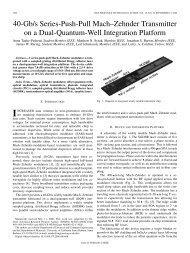62 IEEE JOURNAL OF QUANTUM ELECTRONICS, VOL. 38, NO. 1, JANUARY 2002rate equations [10], as well as photon statistics master equations[10]–[13]. Traveling wave equations have been used in orderto take the spatial distribution <strong>of</strong> carriers, gain, and photonsin in-plane SOAs into account [14]. In a VCSOA, the gain isconcentrated to an extremely small gain region. The signaltraverses the gain region multiple times and experiences thesame gain each time. The traveling wave approach is thereforenot necessary for this case. However, VCSOAs typicallyhave highly reflective mirrors, which greatly affects the noiseproperties. The noise in VCSOAs can be analyzed using thesame methods as for in-plane FPAs. The total output noise froman <strong>optical</strong> amplifier consists <strong>of</strong> several different noise terms <strong>of</strong>different origin. The terms contributing to the total noise are:beating between amplified spontaneous emission (ASE) componentsand the coherent signal light, beating between differentASE components, and shot noise due to both signal and ASE.The input signal might also have some excess noise and thereceiver adds thermal noise. Signal-spontaneous beat noise isindependent <strong>of</strong> the input signal power and is the dominatingterm at low signal power. This term depends on the <strong>optical</strong>bandwidth <strong>of</strong> the ASE spectrum. For this reason, a bandpassfilter is normally used after the <strong>optical</strong> amplifier in order tominimize the amount <strong>of</strong> ASE reaching the detector. This is notneeded for a VCSOA as the spontaneous emission bandwidthis limited by the Fabry–Perot <strong>cavity</strong>. Signal-spontaneous beatnoise and shot noise increase with input signal power. Athigh signal powers, signal-spontaneous beat noise is the maincontributor to the output noise. The output ASE, and hencethe signal-spontaneous beat noise, is greatly affected by themirror reflectivity. Considering signal-spontaneous beat noiseto be dominant, the noise factor , defined as input SNR overoutput SNR (the noise <strong>figure</strong> is defined asand expressed in decibels), is given by[15]. For high signal gain ( ), this reduces toHere, is the population inversion parameter and is the excessnoise coefficient, which describes signal-spontaneous beatnoise enhancement due to finite mirror reflectivity. takes ona value <strong>of</strong> one for zero reflectivity (the case <strong>of</strong> traveling wave<strong>amplifiers</strong>) and values higher than one for finite mirror reflectivities.Using photon statistics master equations as described byShimoda et al. [11], it can be shown that is given by [12](1)(2)wherebottom mirror reflectivity;top mirror reflectivity;single-pass gain;amplifier gain.Here, the signal is exiting the amplifier through the top mirror.VCSOAs can be operated in either transmission or reflectionmode with different expressions for the signal gain . Sinceappears in the denominator <strong>of</strong> (2), the two configurations are associatedwith significantly different expressions for . In transmission-modeoperation, the signal enters the VCSOA from oneside (bottom) and is collected on the other side (top). In reflectionmode, the signal enters and exits the amplifier from thesame side (top). The amplifier gain <strong>of</strong> a VCSOA operated intransmission mode ( ) or reflection mode ( ) is given by [5]Here, is the phase detuning <strong>of</strong>f the <strong>cavity</strong> resonance frequency.For operation at the <strong>cavity</strong> resonance frequency, the sine termsequal zero. Inserting (3) and (4) back into (2), the excess noisecoefficient for the two cases can be shown to beFor transmission mode and high gain ( ), simplifies toThe excess noise coefficient versus amplifier gain for both casesis plotted in Fig. 1(a) and (b), for different mirror reflectivities.The reflectivity <strong>of</strong> VCSOA mirrors is typically much higherthan for those <strong>of</strong> in-plane FP <strong>amplifiers</strong> due to the shorter activeregion <strong>of</strong> VCSOAs and, thereby, lower single-pass gain. VC-SOAs demonstrated to date have all used mirrors with reflectivitieshigher than 0.9. is shown here for mirror reflectivities<strong>of</strong> 0.85 and higher. For transmission-mode operation [Fig. 1(a)],equals one when the single-pass gain is.Itisobviouslydesirable to operate the VCSOA close to this ideal value<strong>of</strong> , but at the same time be able to vary the signal gain .Itis also desirable to maximize in order to achieve high signalgain. This can be achieved by using low input mirror reflectivity( ) and high output mirror reflectivity ( ). This is evidentfrom Fig. 1(a); a value <strong>of</strong> close to one over a wide range <strong>of</strong>signal gain is achieved using and .Forsymmetrical devices, is independent <strong>of</strong> mirror reflectivity.For the case <strong>of</strong> reflection-mode operation [Fig. 1(b)], is afunction <strong>of</strong> bottom mirror reflectivity only. -values close toone can be achieved for bottom mirror reflectivities higher than0.99, which is easily obtained using DBR mirrors.A. Inversion LevelIt is desirable to operate an <strong>optical</strong> amplifier with a populationinversion as high as possible in order to minimize reabsorption<strong>of</strong> the signal light, which is detrimental to the noise <strong>figure</strong>. Thepopulation inversion parameter is defined as [13]where is the carrier density and is the carrier density attransparency. takes on values greater than one for low carrierdensities and reaches unity at complete inversion. A delicateproblem inherent to FPAs is that strong pumping is desiredto reach high carrier density, and thereby minimize , whilethe amplifier still has to be operated in the regime below lasing(3)(4)(5)(6)(7)(8)
BJÖRLIN AND BOWERS: NOISE FIGURE OF VCSOAs 63(a)Fig. 2.threshold.Population inversion parameter versus reflectivity (R 2R ) at lasingbenefit from low mirror reflectivity [2], [7]. It is clear from thediscussion above that low mirror reflectivity is also crucial forachieving a low noise <strong>figure</strong>.B. Coupling EfficiencyFor any practical application, the <strong>of</strong>ten critical parameter isnot the intrinsic noise <strong>figure</strong> <strong>of</strong> a device, but rather its fiber-t<strong>of</strong>ibernoise <strong>figure</strong>. The noise <strong>figure</strong> is degraded by loss associatedwith a coupling <strong>of</strong> signal into and out <strong>of</strong> the device. Thefiber-to-fiber noise factor can be calculated using the equationfor the noise factor <strong>of</strong> cascaded devices [16] as follows:(b)Fig. 1. Excess noise coefficient versus amplifier gain for: (a) transmissionmodeoperation and (b) reflection-mode operation.threshold. The mirror reflectivity governs how hard the amplifiercan be pumped before it reaches lasing threshold. Lasingthreshold is reached when the round trip net gain equals one,i.e.,. The single-pass gain can be deduced fromthe active region design and the material gain, which is a function<strong>of</strong> carrier density. The population inversion can thus belinked to the single-pass gain and, if the reflectivities are known,the population inversion at threshold can be calculated. Fig. 2shows a plot <strong>of</strong> the calculated population inversion parameterat threshold versus mirror reflectivity ( ) for the devicedescribed later in this paper. This marks the lowest possiblevalue <strong>of</strong> for a given reflectivity; in practice, a VCSOAhas to be operated at a slightly lower carrier density in orderto avoid lasing. This particular device has an undoped InP–In-GaAsP active region. The gain model for the device is describedin [7]. The plot is valid for transmission or reflection-mode operation.For a reflection-mode device with bottom mirror reflectivityclose to unity, the -axis in the plot represents top mirrorreflectivity. To achieve an below 1.5, the reflectivity has tobe on the order <strong>of</strong> 0.9 or less. At low reflectivities and high carrierdensities, changes in carrier density have a very small effecton the population inversion and values close to those given bythe <strong>figure</strong> can be achieved. It has previously been shown thatsaturation output power and high gain-bandwidth product bothThe coupling losses can be modeled by attenuators withand noise <strong>figure</strong>s . For an amplifier with gainand intrinsic noise factor , the total noise factor is thengiven by(9)(10)This equation demonstrates that the input coupling loss directlydegrades the noise factor (in logarithmic units, the inputcoupling loss is simply added to the noise <strong>figure</strong>), whereasthe output coupling loss is only significant when the gain issmall. VCSOAs have superior coupling efficiency compared toin-plane devices due to the circularly symmetric cross section<strong>of</strong> the <strong>optical</strong> mode. Coupling loss as low as 1 dB has beenachieved for <strong>vertical</strong>-<strong>cavity</strong> lasers to single-mode fiber [17].Similar output coupling efficiency could be achieved for aVCSOA; the input coupling efficiency should be even lower.To summarize the theory, excess noise coefficients close tounity can be achieved, if the mirror reflectivities are chosen carefully(Fig. 1). High population inversion can also be obtained,using low mirror reflectivities and strong pumping (Fig. 2). Thisindicates that intrinsic noise <strong>figure</strong>s close to 3 dB are possibleto achieve. Assuming high gain and input coupling loss <strong>of</strong> lessthan 1 dB, fiber-to-fiber noise <strong>figure</strong>s <strong>of</strong> about 4 dB should bepossible for VCSOAs.



